计量经济学第5章动态计量经济模型
- 格式:pptx
- 大小:415.06 KB
- 文档页数:50
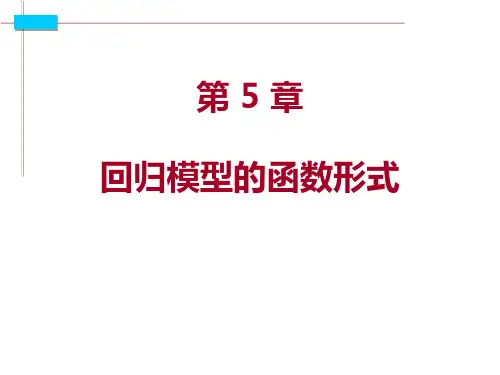
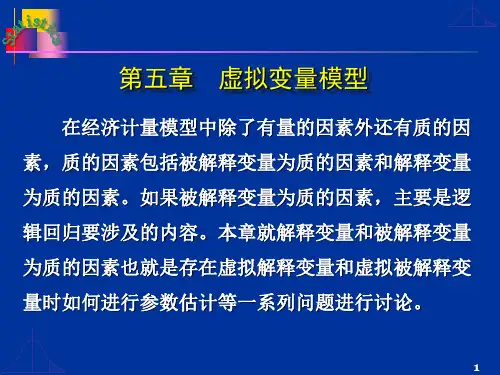

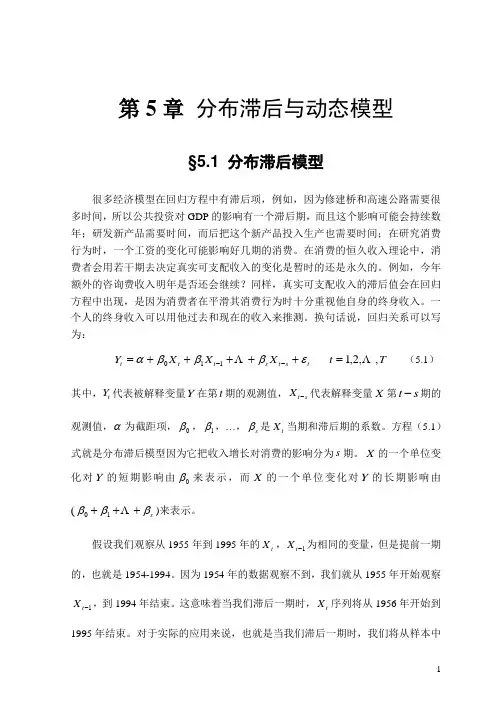
第5章 分布滞后与动态模型§5.1 分布滞后模型很多经济模型在回归方程中有滞后项,例如,因为修建桥和高速公路需要很多时间,所以公共投资对GDP 的影响有一个滞后期,而且这个影响可能会持续数年;研发新产品需要时间,而后把这个新产品投入生产也需要时间;在研究消费行为时,一个工资的变化可能影响好几期的消费。
在消费的恒久收入理论中,消费者会用若干期去决定真实可支配收入的变化是暂时的还是永久的。
例如,今年额外的咨询费收入明年是否还会继续?同样,真实可支配收入的滞后值会在回归方程中出现,是因为消费者在平滑其消费行为时十分重视他自身的终身收入。
一个人的终身收入可以用他过去和现在的收入来推测。
换句话说,回归关系可以写为:T t X X X Y t s t s t t t ,,2,1110 =+++++=--εβββα (5.1) 其中,t Y 代表被解释变量Y 在第t 期的观测值,t s X -代表解释变量X 第t s -期的观测值,α为截距项,0β,1β,…,s β是t X 当期和滞后期的系数。
方程(5.1)式就是分布滞后模型因为它把收入增长对消费的影响分为s 期。
X 的一个单位变化对Y 的短期影响由0β来表示,而X 的一个单位变化对Y 的长期影响由(s βββ+++ 10)来表示。
假设我们观察从1955年到1995年的t X ,1t X -为相同的变量,但是提前一期的,也就是1954-1994。
因为1954年的数据观察不到,我们就从1955年开始观察1t X -,到1994年结束。
这意味着当我们滞后一期时,t X 序列将从1956年开始到1995年结束。
对于实际的应用来说,也就是当我们滞后一期时,我们将从样本中丢失了一个观测值。
所以如果我们滞后s 期,将丢失s 个观测值。
更进一步,对于每一个滞后值,都要估计出一个额外的β值。
因此,自由度会产生双重损失,即观测值数目的减少(因为引进滞后项),以及所需估计的参数增加。
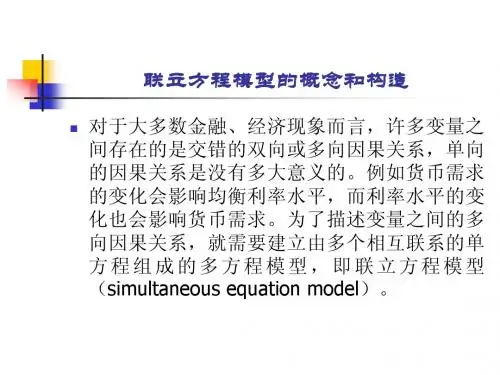

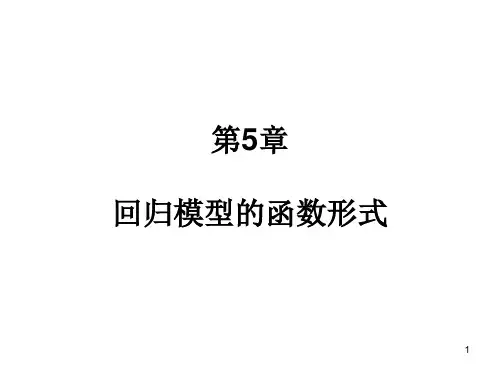

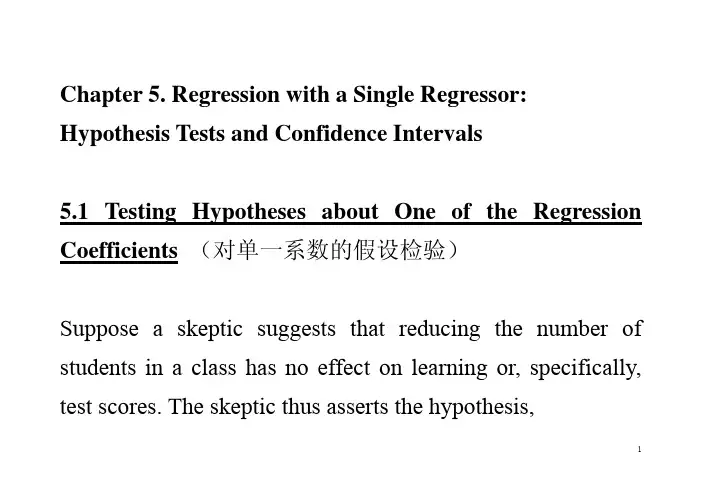
Chapter 5. Regression with a Single Regressor: Hypothesis Tests and Confidence Intervals5.1 Testing Hypotheses about One of the Regression Coefficients(对单一系数的假设检验)Suppose a skeptic suggests that reducing the number of students in a class has no effect on learning or, specifically, test scores. The skeptic thus asserts the hypothesis,1H0: β1 = 0We wish to test this hypothesis using data – reach a tentative conclusion whether it is correct or incorrect.Null hypothesis and two-sided alternative:H0: β1 = 0 vs. H1: β1≠ 0or, more generally,2H0: β1 = β1,0 vs. H1: β1≠β1,0where β1,0 is the hypothesized value under the null(β1,0是一个具体的数).Null hypothesis and one-sided alternative:H0: β1 = β1,0 vs. H1: β1 < β1,0In economics, it is almost always possible to come up with stories in which an effect could “go either way,” so it is34standard to focus on two-sided alternatives.Recall hypothesis testing for population mean using Y :t=Y μ−then reject the null hypothesis if |t | >1.96.where the SE of the estimator is the square root of an estimator of the variance of the estimator.Applied to a hypothesis about β1:t = estimator - hypothesized value standard error of the estimator56sot = 11,01ˆˆ()SE βββ−where β1 is the value of β1,0 hypothesized under the null (for example, if the null value is zero, then β1,0 = 0.What is SE (1ˆβ)? SE (1ˆβ) = the square root of an estimator of the variance7of the sampling distribution of 1ˆβRecall the expression for the variance of 1ˆβ (large n ):var(1ˆβ) = 22var[()]()i X i X X u n μσ− = 24v Xn σσwhere v i = (X i –X )u i . Estimator of the variance of 1ˆβ:812ˆˆβσ = 2221estimator of (estimator of )v Xn σσ× = 2212211ˆ()121()ni i i n i i X X u n n X X n ==−−×⎡⎤−⎢⎥⎣⎦∑∑.OK, this is a bit nasty, but:• There is no reason to memorize this• It is computed automatically by regression software• SE (1ˆβis reported by regression software9• It is less complicated than it seems. The numerator estimates the var(v ), the denominator estimates var(X )2.Return to calculation of the t -statsitic:t = 11,01ˆˆ()SE βββ− =11,0ˆββ−• Reject at 5% significance level if |t| > 1.96•p-value is p = P(|t| > |t act|) = probability in tails of normal outside |t act|•Both the previous statements are based on large-n approximation; typically n = 50 is large enough for the approximation to be excellent.1011 Example: Test Scores and STR , California dataEstimated regression line: n TestScore = 698.9 – 2.28×STRRegression software reports the standard errors:SE (0ˆβ) = 10.4 SE (1ˆβ) = 0.52t -statistic testing “β1,0 = 0” = 11,01ˆˆ()SE βββ− = 2.2800.52−− = –4.38•The 1% 2-sided significance level is 2.58, so we reject the null at the 1% significance level.•Alternatively, we can compute the p-value. You can do this easily in Stata:. di normal(-4.38)*2. 00001187注:在Stata中,normal表示标准正态分布的cdf。
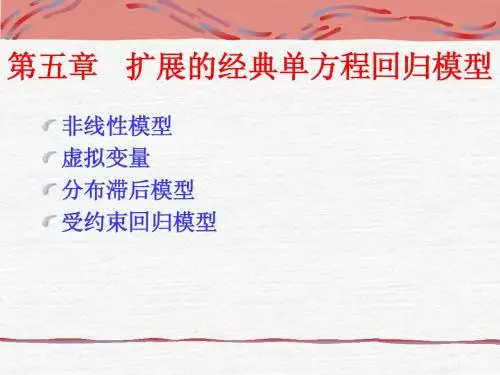

第五章 多元线性回归模型在第四章中,我们讨论只有一个解释变量影响被解释变量的情况,但在实际生活中,往往是多个解释变量同时影响着被解释变量。
需要我们建立多元线性回归模型。
一、多元线性模型及其假定 多元线性回归模型的一般形式是i iK K i i i x x x y εβββ++++= 2211令列向量x 是变量x k ,k =1,2,的n 个观测值,并用这些数据组成一个n ×K 数据矩阵X ,在多数情况下,X 的第一列假定为一列1,则β1就是模型中的常数项。
最后,令y 是n 个观测值y 1, y 2, …, y n 组成的列向量,现在可将模型写为:εββ++=K K x x y 11构成多元线性回归模型的一组基本假设为 假定1. εβ+=X y我们主要兴趣在于对参数向量β进行估计和推断。
假定2. ,0][][][][21=⎥⎥⎥⎥⎦⎤⎢⎢⎢⎢⎣⎡=n E E E E εεεε 假定3. n I E 2][σεε='假定4. 0]|[=X E ε我们假定X 中不包含ε的任何信息,由于)],|(,[],[X E X Cov X Cov εε= (1)所以假定4暗示着0],[=εX Cov 。
(1)式成立是因为,对于任何的双变量X ,Y ,有E(XY)=E(XE(Y|X)),而且])')|()([(])')((),(EY X Y E EX X E EY Y EX X E Y X Cov --=--=))|(,(X Y E X Cov =这也暗示 βX X y E =]|[假定5 X 是秩为K 的n ×K 随机矩阵 这意味着X 列满秩,X 的各列是线性无关的。
在需要作假设检验和统计推断时,我们总是假定: 假定6 ],0[~2I N σε 二、最小二乘回归 1、最小二乘向量系数采用最小二乘法寻找未知参数β的估计量βˆ,它要求β的估计βˆ满足下面的条件 22min ˆ)ˆ(ββββX y X y S -=-∆ (2)其中()()∑∑==-'-=⎪⎪⎭⎫ ⎝⎛-∆-nj Kj j ij i X y X y x y X y 1212ββββ,min 是对所有的m 维向量β取极小值。